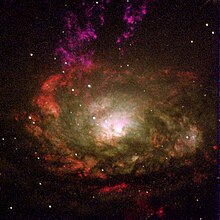
Seyfert galaxies are one of the two largest groups of active galaxies, along with quasar host galaxies. They have quasar-like nuclei (very luminous sources of electromagnetic radiation that are outside of our own galaxy) with very high surface brightnesses whose spectra reveal strong, high-ionisation emission lines,[1] but unlike quasars, their host galaxies are clearly detectable.[2]
Seyfert galaxies account for about 10% of all galaxies[3] and are some of the most intensely studied objects in astronomy, as they are thought to be powered by the same phenomena that occur in quasars, although they are closer and less luminous than quasars. These galaxies have supermassive black holes at their centers which are surrounded by accretion discs of in-falling material. The accretion discs are believed to be the source of the observed ultraviolet radiation. Ultraviolet emission and absorption lines provide the best diagnostics for the composition of the surrounding material.[4]
Seen in visible light, most Seyfert galaxies look like normal spiral galaxies, but when studied under other wavelengths, it becomes clear that the luminosity of their cores is of comparable intensity to the luminosity of whole galaxies the size of the Milky Way.[5]
Seyfert galaxies are named after Carl Seyfert, who first described this class in 1943.[6]
- ^ Cite error: The named reference
Peterson1997was invoked but never defined (see the help page). - ^ Cite error: The named reference
Bulgariawas invoked but never defined (see the help page). - ^ Cite error: The named reference
Maiolinowas invoked but never defined (see the help page). - ^ Cite error: The named reference
Davidsenwas invoked but never defined (see the help page). - ^ Cite error: The named reference
Soperwas invoked but never defined (see the help page). - ^ Cite error: The named reference
Seyfertwas invoked but never defined (see the help page).